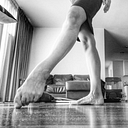Ballet dictionary for adults. How to do a passé
Welcome to the Ballet Dictionary for Adults, episode #6. “Ballet Dictionary for adults” is a project where I give thorough explanation of basic ballet movements with tips and tricks specifically for adult ballerinas. I also give links to useful videos from the ballet teachers that I trust.
In this session I will talk about how to do a passé.
In my explanations I go by the legendary book “Basic principals of classical ballet” by Vaganova. Lifehacks for adults are purely my own (I’ve been doing ballet for 11 years in total, I write about it in my blog) observations and experience. I only give the tips that actually did work for me.
What is passé?
Vaganova writes that passé “is an auxiliary movement which transfers (passes) the leg from one position into another”.
At adult ballet classes a passé is often trained as a pose, not only a movement. For example, at the end of many exercises my teacher asks to go to passé and stay there for a while.
That’s the moment when my legs and my whole body start to shake (especially if I’m doing passé on demi-points) from a huge effort I’m making, because it’s so difficult to hold yourself in passé and follow all those rules (straight hips, straight body, standing firmly, not falling, etc, etc..)
Adult ballet students need to train passé as a pose, not just as a movement, to be able to deeply understand it and automate the skill. The thing is, as a movement, a passé is really quick, sometimes hard to grasp (for example, when performed by a professional dancer in a sequence of movements). If not trained separately, it won’t look good enough, especially when performed by amateurs. Us, adult ballet students, need to care a lot about the beauty of the detail, as we definitely cannot boast super flexibility or a 180 degree leg in a grand battement. A passé is a detail, but a beautiful one, which makes the whole exercise nice to look at.
Passé rules from Vaganova
Passé corresponds to its French meaning (passed). It is an auxiliary movement which transfers (passes) the leg from one position into another.
If you are standing developpe efface forward and you wish to bring the leg back into arabesque without doing a grand rond de jambe, you bend the leg at the knee, leaving it at a height of 90 degrees, brush the toe of that foot past the standing leg and bring it out into arabesque. The passing of the leg through this path is called passé.
The same movement can be done with a jump, leaving the floor with the supporting leg. It will also be called passé.
Tips for adults
- Try to hold your leg high. Fun fact: there’s not a single indication in Vaganova book that, when doing a passé, you need to raise your working knee as high as you can. While, everybody is taught that passé should be high. “The higher your passé is, the more you will earn”, goes the joke of one of my ex ballet teachers (it rhymes in a funny way in the Russian language). In fact, a high passé helps you a lot with pirouettes and it looks much nicer than a low one.
- The knee of your working leg should strive in the direction behind your back. The whole gist of passé is not just bending your knee, but as if trying to make it go behind your back.
- Raise the knee, not the hip. In passé, it’s the knee that goes up, not the hip. Do not raise your hip just because it makes your leg go higher. Hips should remain very straight. You can raise your knee only as far as your hips allow you.
Tip from my teacher: go to grand plie (hold on to a barre or a chair), and then go up to standing position with one leg, the other leg being in the same position as in grand plie (bent in passé). In this way, you can really understand how the working leg in passé should feel like. Basically, grand plie is passé, but on the floor and with both legs :)
4. Hold your body axis correctly. When doing passé, your weight should automatically go to the standing leg. So, your body from your standing foot up to the tip of the head on the side of the standing foot — that’s your axis, that helps you stay firm at passé. That helps especially when you’re doing passé in demi-points.
5. If you’re falling, make your passé lower. Yes, I said above that your goal is a high passé. But It should be high ONLY IF you’re able to stay firmly while holding it high.
Previous episodes in Ballet Dictionary for Adults
Author — Evgenia Budrina. I am a dance enthusiast from Russia.
I started doing ballet at 31. In my blog I write about and for those who started dancing as adults and take it seriously. Personal stories, failures, life-hacks and thoughts.
My Instagram — @_a.dancer_
